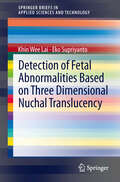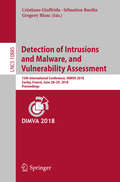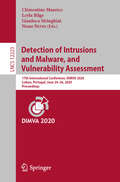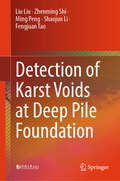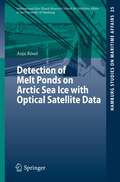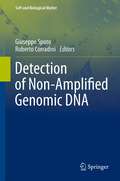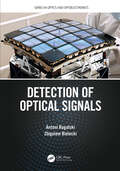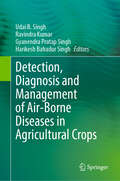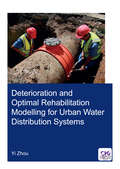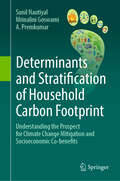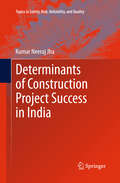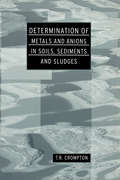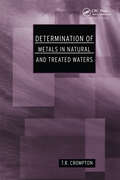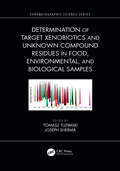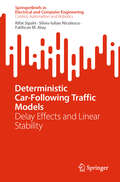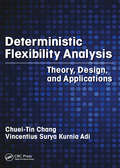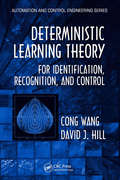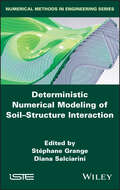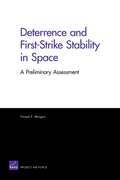- Table View
- List View
Detection of Corona Discharge in Electric Networks (Studies in Systems, Decision and Control #509)
by Artur Zaporozhets Yevgen Sokol Vitalii Babak Oleg Gryb Ihor KarpaliukThe book is devoted to the solution of the problem of determining the presence of corona discharge on electrical equipment with acoustic radiation. It is shown that corona discharge leads not only to irreversible losses of electrical energy, but also interferes with the transmission of high-frequency signals, deteriorates insulating elements, can become a source of conditions for the occurrence of a destructive arc discharge and is one of the factors of changing the continuity of the electrical system as a whole. The book describes the processes in a corona discharge that lead to the occurrence of acoustic waves. The authors analyzed acoustic radiation from a corona discharge reproduced in laboratory conditions. The received acoustic signals were processed by Fourier transform. Thus, the features of the spectral function, which belong specifically to the corona discharge in electrical networks with industrial frequency current, were determined. Based on the inverse Fourier transform, a simplified model of the acoustic radiation of the corona discharge was constructed. The authors proposed a method for detecting the presence of a corona discharge based on the spectral characteristics of acoustic radiation. Techniques were developed to determine the presence of a corona discharge for the creation of stationary and mobile devices. The advantages of the method of detecting the presence of corona discharge by the acoustic spectrum are shown. The method makes it possible to determine the presence of a corona discharge remotely, even out of direct sight, regardless of the time of day and regardless of the season. The book states that determining the presence of a corona discharge is not enough, it is still necessary to determine its location. The method of finding the coordinates of the corona discharge as a source of sound was described. Methods of searching for corona discharge coordinates with a fixed scanning device and a moving scanning device are proposed. A UAV is proposed as a mobile platform for the scanning system. The influence of the Doppler effect on acoustic measurements when the UAV speed changes was taken into account. The authors have shown that the use of coronal discharge detection with UAVs will not only enable the prevention of coronal discharge, but also increase the frequency of surface inspections. This will allow timely measures to be taken to improve the reliability of the power system operation. The book is intended for the researchers, postgraduate students and students specialized in theory and calculations of electrical systems.
Detection of False Data Injection Attacks in Smart Grid Cyber-Physical Systems (Wireless Networks)
by Rongxing Lu Gaoxi Xiao Beibei LiThis book discusses cybersecurity issues of smart grid cyber-physical systems, focusing on the detection techniques against false data injection attacks. The authors discuss passive and proactive techniques that combat and mitigate two categories of false data injection attacks, false measurement data injections and false command data injections in smart grid cyber-physical systems. These techniques are easy to follow for either professionals or beginners. With this book, readers can quickly get an overview of this topic and get ideas of new solutions for false data injections in smart grid cyber-physical systems. Readers include researchers, academics, students, and professionals.Presents a comprehensive summary for the detection techniques of false data injection attacks in smart grid cyber-physical systems; Reviews false data injections for either measurement data or command data; Analyzes passive and proactive approaches to smart grid cyber-physical systems.
Detection of Fetal Abnormalities Based on Three Dimensional Nuchal Translucency
by Khin Wee Lai Eko SupriyantoUltrasound (US) prenatal screening has been proposed as the most effective technique for Trisomy 21 early assessment. Assessment of Nuchal Translucency (NT) offers promising non-invasive method for fetal abnormalities detection up to 75%. Nevertheless, current clinician practice of NT examination by locating the sonogram calipers on 2D US image requires highly trained and competent operators by adhering to a standard tedious protocol; therefore it is prone to errors and hence it decreases the reliability in intra- and inter-observer repeatability. This Brief provides the basic knowledge regarding Trisomy 21 diseases and its existing detection methods. The restrictions and disadvantages of each method are discussed accordingly. Therefore, a non-invasive early detection method using 3D ultrasound reconstruction of Nuchal Translucency is introduced. This new method for 3D NT assessments has an edge over the previous 2D methods, and entails the composite function in visualizing the explicit internal marker structure. Further, image processing techniques covered from data acquisition, pre-processing, speckle noise reduction and 3D segmentation are also discussed. This should be especially useful for students and professional researchers in the Biomedical and image processing fields.
Detection of Intrusions and Malware, and Vulnerability Assessment: 15th International Conference, DIMVA 2018, Saclay, France, June 28–29, 2018, Proceedings (Lecture Notes in Computer Science #10885)
by Gregory Blanc Cristiano Giuffrida Sébastien BardinThis book constitutes the refereed proceedings of the 15th International Conference on Detection of Intrusions and Malware, and Vulnerability Assessment, DIMVA 2018, held in Saclay, France, in June 2018. The 17 revised full papers and 1 short paper included in this book were carefully reviewed and selected from 59 submissions. They present topics such as malware analysis; mobile and embedded security; attacks; detection and containment; web and browser security; and reverse engineering.
Detection of Intrusions and Malware, and Vulnerability Assessment: 17th International Conference, DIMVA 2020, Lisbon, Portugal, June 24–26, 2020, Proceedings (Lecture Notes in Computer Science #12223)
by Clémentine Maurice Nuno Neves Leyla Bilge Gianluca StringhiniThis book constitutes the proceedings of the 17th International Conference on Detection of Intrusions and Malware, and Vulnerability Assessment, DIMVA 2020, held in Lisbon, Portugal, in June 2020.* The 13 full papers presented in this volume were carefully reviewed and selected from 45 submissions. The contributions were organized in topical sections named: vulnerability discovery and analysis; attacks; web security; and detection and containment. *The conference was held virtually due to the COVID-19 pandemic.
Detection of Karst Voids at Deep Pile Foundation
by Zhenming Shi Ming Peng Liu Liu Shaojun Li Fengjuan TaoKarst voids at pile locations can have a significant negative impact on the bearing capacity and overall safety of cast-in-place pile foundations. This book introduces a state-of-the-art detection system, comprising of specialized equipment, algorithms, and software, designed to identify karst voids during deep cast-in-place pile foundation construction. The system includes a unique multifrequency borehole sonic probe, a single borehole radar, two pile hole sonar probes, and a corresponding signal analysis method. Several field and synthetic tests have been conducted to detect karst voids during cast-in-place pile foundation construction, and the results demonstrate that this technology can offer detailed geological information for pile design and ensure the safety of foundation construction. The work presented in this book has received the First Prize for Technological Invention in Shanghai, China in 2022.
Detection of Melt Ponds on Arctic Sea Ice with Optical Satellite Data
by Anja RöselThe Arctic sea ice is characterized by profound changes caused by surface melting processes and the formation of melt ponds in summer. Melt ponds contribute to the ice-albedo feedback as they reduce the surface albedo of sea ice, and hence accelerate the decay of Arctic sea ice. To quantify the melting of the entire Arctic sea ice, satellite based observations are necessary. Due to different spectral properties of snow, ice, and water, theoretically, multi-spectral optical sensors are necessary for the analysis of these distinct surface types. This study demonstrates the potential of optical sensors to detect melt ponds on Arctic sea ice. For the first time, an Arctic-wide, multi-annual melt pond data set for the years 2000-2011 has been created and analyzed.
Detection of Non-Amplified Genomic DNA
by Roberto Corradini Giuseppe SpotoThis book offers an overview of state-of-the-art in non amplified DNA detection methods and provides chemists, biochemists, biotechnologists and material scientists with an introduction to these methods. In fact all these fields have dedicated resources to the problem of nucleic acid detection, each contributing with their own specific methods and concepts. This book will explain the basic principles of the different non amplified DNA detection methods available, highlighting their respective advantages and limitations. Non-amplified DNA detection can be achieved by adopting different techniques. Such techniques have allowed the commercialization of innovative platforms for DNA detection that are expected to break into the DNA diagnostics market. The enhanced sensitivity required for the detection of non amplified genomic DNA has prompted new strategies that can achieve ultrasensitivity by combining specific materials with specific detection tools. Advanced materials play multiple roles in ultrasensitive detection. Optical and electrochemical detection tools are among the most widely investigated to analyze non amplified nucleic acids. Biosensors based on piezoelectric crystal have been also used to detect unamplified genomic DNA. The main scientific topics related to DNA diagnostics are discussed by an outstanding set of authors with proven experience in this field.
Detection of Optical Signals (Series in Optics and Optoelectronics)
by Antoni Rogalski Zbigniew BieleckiDetection of Optical Signals provides a comprehensive overview of important technologies for photon detection, from the X-ray through ultraviolet, visible, infrared to far-infrared spectral regions. It uniquely combines perspectives from many disciplines, particularly within physics and electronics, which are necessary to have a complete understanding of optical receivers.This interdisciplinary textbook aims to: Guide readers into more detailed and technical treatments of readout optical signals Give a broad overview of optical signal detection including terahertz region and two-dimensional material Help readers further their studies by offering chapter-end problems and recommended reading. This is an invaluable resource for graduate students in physics and engineering, as well as a helpful refresher for those already working with aerospace sensors and systems, remote sensing, thermal imaging, military imaging, optical telecommunications, infrared spectroscopy, and light detection.
Detection, Diagnosis and Management of Air-Borne Diseases in Agricultural Crops
by Harikesh Bahadur Singh Ravindra Kumar Gyanendra Pratap Singh Udai B. SinghThis edited volume covers latest information and developments on the Detection, Diagnosis and Management of Air-Borne Diseases of Agricultural Crops across the globe. The main aim of this book is to address the scientific and practical significance of detection, diagnosis and management of air-Borne plant pathogens. With the advancement of science, OMICs approaches playing crucial role in the efficient and accurate detection of pathogen propagules present in the air or on the plant surface. This book volume cover almost all molecular techniques used for detection and diagnosis of air-borne phyto-pathogens. Similarly, all possible management practices with detailed description are discussed in the present book volume. Special attention has been given on the microbe-mediated management of air-borne disease. Among the more recent strategies, resistance induced by environment-friendly elicitors of microbial origin and/or rhizosphere/phyllosphere microbes has emerged as a promising supplement in the approaches to crop protection. This book covers all spheres of microbial management viz., bio-resources, diversity, ecology, and functioning of microbial biocontrol agents, host–parasite interaction, strategies to characterize microbial bioinoculants, application of microbial bio-pesticides and regulatory mechanisms pertaining to commercialization of biopesticides. This book is of interest to teachers, researchers, crop protection scientists, capacity builders and policymakers. Also, the book serves as additional reading material for under-graduate, post-graduate, and post-doctorate fellow of agriculture, forestry, ecology, life science, and environmental sciences.
Detectors in Particle Physics: A Modern Introduction
by Tony Weidberg Georg ViehhauserThis textbook provides an accessible yet comprehensive introduction to detectors in particle physics. It emphasises the core physics principles, enabling a deeper understanding of the subject for further and more advanced studies. In addition to the discussion of the underlying detector physics, another aspiration of this book is to introduce the reader to practically important aspects of particle detectors, like electronics, alignment, calibration and simulation of particle detectors. Case studies of the various applications of detectors in particle physics are provided.The primary audience is graduate students in particle or nuclear physics, in addition to advanced undergraduate students in physics.Key Features: Provides an accessible yet thorough discussion of the basic physics principles needed to understand how particle detectors work. Presents applications of the basic physics concepts to examples of modern detectors. Discusses practically important aspects like electronics, alignment, calibration and simulation of particle detectors. Contains exercises for each chapter to further understanding. For more information and errata please see the authors companion webpage https://ppdetectors.web.ox.ac.uk/This webpage also allows instructors to request a copy of the solutions manual. This eBook was published Open Access with funding support from the Sponsoring Consortium for Open Access Publishing in Particle Physics (SCOAP3).
Deterioration and Optimal Rehabilitation Modelling for Urban Water Distribution Systems (IHE Delft PhD Thesis Series)
by Yi ZhouPipe failures in water distribution systems can have a serious impact and hence it’s important to maintain the condition and integrity of the distribution system. This book presents a whole-life cost optimisation model for the rehabilitation of water distribution systems. It combines a pipe breakage number prediction model with a pipe criticality assessment model, which enables the creation of a well-constructed and more tightly constrained optimisation model. The pipe breakage number prediction model combines information on the physical characteristics of the pipes with historical information on breakage and failure rates. A weighted multiple nonlinear regression analysis is applied to describe the condition of different pipe groups. The criticality assessment model combines a pipe’s condition with its hydraulic significance through a modified TOPSIS. This model enables the optimisation to focus its efforts on those important pipes. The whole life cost optimal rehabilitation model is a multiple-objective and multiple-stage model, which provides a suite of rehabilitation decisions that minimise the whole life cost while maximising its long-term performance. The optimisation model is solved using a modified NSGA-II. The utility of the developed models is that it allows decision makers to prioritize their rehabilitation strategy in a proactive and cost-effective manner.
Determinants and Stratification of Household Carbon Footprint: Understanding the Prospect for Climate Change Mitigation and Socioeconomic Co-benefits
by Sunil Nautiyal Mrinalini Goswami A PremkumarThis book provides comprehensive insights into the socioeconomic systems, carbon accounting, and consumption-expenditure frameworks influencing household carbon footprints (HCF) in a developing economy. It offers a unique perspective on the link between socioeconomic classes, agro-ecological zones, and carbon emissions, specifically in the Indian context. Household consumption patterns play a critical role in determining greenhouse gas emissions and are increasingly recognized as vital for shaping effective climate policies. Various socio-economic, demographic, and lifestyle factors—such as household size, income, food habits, mobility choices, waste management practices, home appliances, and education—significantly impact HCF. While the IPCC mitigation framework focuses extensively on direct emissions from energy and product production, this book emphasizes indirect emissions driven by lifestyle choices and end-use consumption. The book is based on a PAN-India study across 13 diverse locations within nine agro-ecological regions, examining the socioeconomic and geo-climatic determinants of household carbon emissions. It explores the income-consumption relationship, providing strategies to leverage these insights for targeted decarbonization and sustainable development. Additionally, the book addresses the behavioral aspects of carbon footprints and offers policy recommendations to promote a "carbon handprint"—advocating for carbon-friendly behaviors and solutions that are socially acceptable. By segregating emissions from production and consumption, it aims to guide the development of comprehensive emission reduction strategies for various consumables. This volume is an essential resource for students, researchers, and policymakers interested in sustainable consumption, climate mitigation, and the socio-economic dimensions of carbon emissions in developing countries.
Determinants of Construction Project Success in India
by Kumar Neeraj JhaThis study presents exploratory work and seeks to identify and evaluate the success and failure factors that could form a guideline for further study and to some extent help professionals to understand some critical aspects that impact project performance concerning construction in India. A total of 55 attributes affecting the performance of construction projects are analysed in terms of their level of influence on four key performance criteria - schedule, cost, quality, and no disputes - using a two-stage questionnaire survey. These attributes are then further analysed, interpreted and evaluated. Based on the critical success factors obtained from the study, a neural network model-based predictive model for project performance has been developed. The performance prediction models have been derived for all four project performance criteria. Further, a hypothesis that 'project success' is influenced by 'success traits' has also been formulated. The hypothesized positive inter-relationships between success traits and project success have been tested using the structural equation modelling technique. Besides supporting the intuition of past researchers in recognizing 'coordination' as a key success factor, this study has revealed that coordination is not an isolated and independent activity, but is a typical management function with an inherent role in all major management activities. Key elements affecting coordination have also been identified and their influence on coordination effort has been studied. Furthermore, the present study has also identified three broad skill groups required of effective project coordinators. The results are validated through case studies of live projects and structured interviews with experts in the field of construction management.
Determination of Anions in Natural and Treated Waters
by T R CromptonAs environmental controls are lagging behind industrial development, metals are an increasing hazard to humans, animal and plant life. Bioaccumulation of metals through the food chain creates a serious impact on public health yet analytical techniques for detecting the often low concentrations of contaminants are poorly understood. Determination of
Determination of Metals and Anions in Soils, Sediments and Sludges (Determination Techniques - The Complete Set Ser.)
by T R CromptonDetermination of Metals and Anions in Soils, Sediments and Sludges is the first volume which comprehensively discusses the range of methods currently available for the analysis of metals and anions in soils, river and marine sediments and industrial sludges. There are specialist chapters on sampling, pollutant accumulation in sediments and bioaccumulation from soils to crops. A particular feature of this volume is its coverage of solid sewage, which is increasingly being applied to land as a fertilizer. An essential reference for chemists and toxicologists involved in water resource management, agrochemistry, fisheries and public health.
Determination of Metals in Natural and Treated Water (Determination Techniques - The Complete Set)
by T R CromptonDetermination of Metals in Natural and Treated Waters draws together all the available literature and presents in a systematic fashion the latest analytical techniques for detecting metals in non-saline and saline natural and treated water. Broad outlines of different methods and their applicability in certain situations are given allowing the chem
Determination of Target Xenobiotics and Unknown Compound Residues in Food, Environmental, and Biological Samples (Chromatographic Science Series)
by Tomasz Tuzimski Joseph ShermaXenobiotics are chemical compounds foreign to a given biological system. In animals and humans, xenobiotics include drugs, drug metabolites, and environmental pollutants. In the environment, xenobiotics include synthetic pesticides, herbicides, and industrial pollutants. Many techniques are used in xenobiotics residue analysis; the method selected depends on the complexity of the sample, the nature of the matrix/analytes, and the analytical techniques available. This reference will help the analyst develop effective and validated analytical strategies for the analysis of hundreds of different xenobiotics on hundreds of different sample types, quickly, accurately and at acceptable cost.
Deterministic Car-Following Traffic Models: Delay Effects and Linear Stability (SpringerBriefs in Electrical and Computer Engineering)
by Silviu-Iulian Niculescu Rifat Sipahi Fatihcan M. AtayThis book is a study of the effects of delays, stemming from a range of sources, on the behaviour of traffic flow. It provides the reader with theoretical approaches and computational tools, including existing tools from the field of control systems, for analysing the stability and slinky features of dynamical systems affected by time delays. Through examples and case-studies it shows how to implement these tools on a variety of traffic-flow models. The models considered are microscopic flow models (dealing with the behaviour of individual vehicles rather than the study of group effects) formulated as continuous-time deterministic delay-differential equations. Physiological lag (human reaction), mechanical time-lag and the delay time of vehicular motion are only a few examples of the multitude of delays that are applied to a traffic model. Such delays may also be discrete (constant), distributed or time-varying; the text concentrates on the constant and distributed delays associated with the representation of linear stability and slinky features to allow a compact and analytically tractable demonstration of the intricacy of delay effects. Readers with an academic research background in applied maths, vehicle dynamics and traffic modelling and graduate students working in those fields will find this brief to be an interesting source of results and openings for further work. It is also useful for engineers working on traffic-management systems and the guidance and control of autonomous vehicles.
Deterministic Flexibility Analysis: Theory, Design, and Applications
by Chuei-Tin Chang Vincentius Surya Kurnia AdiTraditionally, design and control decisions are made in sequential stages over the life cycle of a chemical plant. In the design phase, the optimal operating conditions and the corresponding material and energy balance data are established mainly on the basis of economic considerations. In the subsequent step, the control systems are configured to maintain the key process conditions at the fixed nominal values. Because it is often desirable to address the operability issues at the earliest possible stage before stipulation of control schemes, the systematic incorporation of flexibility analysis in process synthesis and design has received considerable attention in recent years. This book focuses to a large extent on computation and implementation methods of deterministic performance measures, i.e., the steady-state, volumetric, dynamic and temporal flexibility indices, in various applications. The formal definitions of several available performance indices, their mathematical formulations, and the corresponding algorithms and codes are provided in sufficient detail to facilitate implementation. To show the utility of flexibility analyses, the book presents several practical case studies including membrane modules and heat-exchanger networks, solar-driven membrane distillation desalination systems, and hybrid power generation systems. It also includes MATLAB and GAMS codes.
Deterministic Learning Theory for Identification, Recognition, and Control (Automation and Control Engineering #32)
by Cong Wang David J. HillDeterministic Learning Theory for Identification, Recognition, and Control presents a unified conceptual framework for knowledge acquisition, representation, and knowledge utilization in uncertain dynamic environments. It provides systematic design approaches for identification, recognition, and control of linear uncertain systems. Unlike many books currently available that focus on statistical principles, this book stresses learning through closed-loop neural control, effective representation and recognition of temporal patterns in a deterministic way. A Deterministic View of Learning in Dynamic Environments The authors begin with an introduction to the concepts of deterministic learning theory, followed by a discussion of the persistent excitation property of RBF networks. They describe the elements of deterministic learning, and address dynamical pattern recognition and pattern-based control processes. The results are applicable to areas such as detection and isolation of oscillation faults, ECG/EEG pattern recognition, robot learning and control, and security analysis and control of power systems. A New Model of Information Processing This book elucidates a learning theory which is developed using concepts and tools from the discipline of systems and control. Fundamental knowledge about system dynamics is obtained from dynamical processes, and is then utilized to achieve rapid recognition of dynamical patterns and pattern-based closed-loop control via the so-called internal and dynamical matching of system dynamics. This actually represents a new model of information processing, i.e. a model of dynamical parallel distributed processing (DPDP).
Deterministic Numerical Modeling of Soil Structure Interaction
by Diana Salciarini Stéphane GrangeIn order to describe soil–structure interaction in various situations (nonlinear, static, dynamic, hydro-mechanical couplings), this book gives an overview of the main modeling methods developed in geotechnical engineering. The chapters are centered around: the finite element method (FEM), the finite difference method (FDM), and the discrete element method (DEM). Deterministic Numerical Modeling of Soil–Structure Interaction allows the reader to explore the classical and well-known FEM and FDM, using interface and contact elements available for coupled hydro-mechanical problems.Furthermore, this book provides insight on the DEM, adapted for interaction laws at the grain level. Within a classical finite element framework, the concept of macro-element is introduced, which generalizes constitutive laws of SSI and is particularly straightforward in dynamic situations. Finally, this book presents the SSI, in the case of a group of structures, such as buildings in a town, using the notion of metamaterials and a geophysics approach.
Deterministic Solvers for the Boltzmann Transport Equation
by Anh-Tuan Pham Sung-Min Hong Christoph JungemannThe book covers all aspects from the expansion of the Boltzmann transport equation with harmonic functions to application to devices, where transport in the bulk and in inversion layers is considered. The important aspects of stabilization and band structure mapping are discussed in detail. This is done not only for the full band structure of the 3D k-space, but also for the warped band structure of the quasi 2D hole gas. Efficient methods for building the Schrödinger equation for arbitrary surface or strain directions, gridding of the 2D k-space and solving it together with the other two equations are presented.
Deterministic, Stochastic, and Deep Learning Methods for Computational Electromagnetics
by Wei CaiThis book provides a well-balanced and comprehensive picture based on clear physics, solid mathematical formulation, and state-of-the-art useful numerical methods in deterministic, stochastic, deep neural network machine learning approaches for computer simulations of electromagnetic and transport processes in biology, microwave and optical wave devices, and nano-electronics. Computational research has become strongly influenced by interactions from many different areas including biology, physics, chemistry, engineering, etc. A multifaceted approach addressing the interconnection among mathematical algorithms and physical foundation and application is much needed to prepare graduate students and researchers in applied mathematics and sciences and engineering for innovative advanced computational research in many applications areas, such as biomolecular solvation in solvents, radar wave scattering, the interaction of lights with plasmonic materials, plasma physics, quantum dots, electronic structure, current flows in nano-electronics, and microchip designs, etc.
Deterrence and First-Strike Stability in Space
by Forrest E. MorganSpace stability appears to be eroding as a growing number of states acquire the ability to degrade or destroy U.S. space assets. The United States needs a coordinated national space deterrence strategy designed to operate on both sides of a potential adversary's cost-benefit decision calculus. Future research will determine the most effective and affordable mix of strategies, policies, and systems for strengthening space deterrence.


